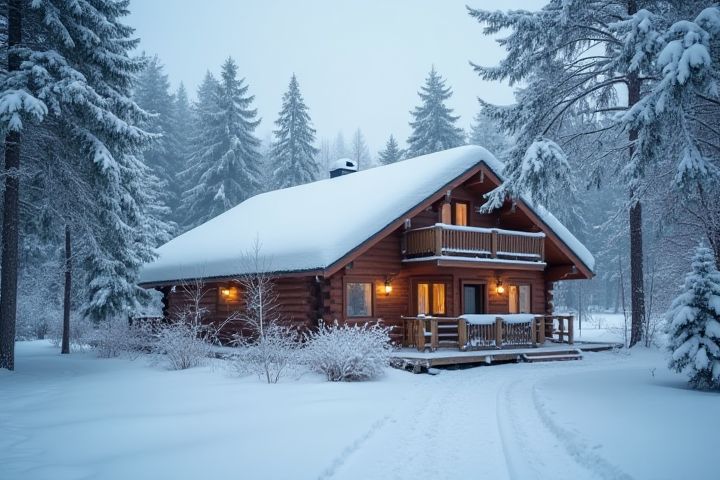
To maintain a house in winter, focus on proper insulation to prevent heat loss and reduce energy bills; check for drafts around windows and doors, using weather stripping or caulk for sealing gaps. Ensure your heating system is functioning efficiently by scheduling regular maintenance and replacing filters as needed. Protect your plumbing by insulating pipes in unheated areas, which can prevent freezing and burst pipes. Keep your roof and gutters clear of snow and ice buildup to avoid structural damage and water infiltration. Lastly, prepare for emergencies by stocking up on supplies like batteries, flashlights, and non-perishable food in case of power outages.
How To Maintain A House In Winter
Insulate windows and doors
To maintain your house in winter, start by insulating windows and doors effectively to prevent heat loss. Use weather stripping or caulking to seal gaps, reducing drafts and minimizing cold air infiltration. Consider installing thermal curtains or window film for added insulation, which can significantly lower heating costs. Regularly check and replace any damaged seals to ensure your home remains warm and energy-efficient throughout the cold months.
Maintain the heating system
To maintain your heating system in winter, schedule a professional inspection at least once a year to ensure optimal performance and efficiency. Replace or clean air filters every one to three months, as clogged filters can reduce airflow and strain your system. Check and insulate ducts to minimize heat loss, which can save you up to 30% on heating costs. It's also wise to monitor thermostat settings, adjusting them to lower temperatures when you are away, which can further enhance energy savings.
Check and seal gaps for drafts
To maintain your house in winter, inspecting and sealing gaps around windows and doors is crucial for energy efficiency. Look for drafts by feeling for cold air or using a candle to detect air movement around frames. Apply weatherstripping or caulk where necessary to eliminate these leaks, enhancing your home's insulation. With proper sealing, you reduce heating costs while creating a more comfortable indoor environment for you and your family.
Clean gutters and downspouts
Regularly cleaning your gutters and downspouts during winter prevents ice dams and water damage to your home. Ensure that all debris, such as leaves and twigs, is removed to facilitate proper drainage. Inspect downspouts for blockages, directing water at least five feet away from your foundation to safeguard against flooding. Investing in gutter guards can further minimize maintenance and keep your system functioning effectively throughout the snowy season.
Protect pipes from freezing
To protect your pipes from freezing in winter, ensure proper insulation around exposed plumbing, particularly in unheated areas like basements, attics, and garages. You can use pipe insulation sleeves or heat tape, which provide an added layer of warmth to prevent ice formation. During extremely cold spells, let faucets drip slowly to keep water flowing and reduce pressure build-up in your pipes. It's also wise to keep your home's thermostat set to a consistent temperature, even when you're away, to avoid drastic drops that could lead to freezing.
Inspect the roof for leaks
Inspecting the roof for leaks during winter is crucial for maintaining your home's integrity. Snow and ice accumulation can lead to ice dams, causing water to seep underneath shingles and create leaks. Regularly check for damaged shingles, cracked flashing, or loose roofing materials, which are common culprits of leaks. Addressing these issues promptly will help you avoid costly repairs and ensure your home remains safe and dry throughout the winter months.
Store outdoor furniture
To maintain your house in winter, properly storing outdoor furniture is essential for longevity and appearance. Begin by cleaning each piece with soap and water to remove dirt and grime, ensuring it is completely dry before storage to prevent moisture-related damage. Use protective covers or tarps made from breathable materials to shield the furniture from snow and ice if storage indoors isn't feasible. If space allows, consider placing outdoor furniture in a temperature-controlled area, like a garage or basement, to protect it from extreme temperature fluctuations.
Test smoke and carbon monoxide detectors
Regularly test smoke and carbon monoxide detectors in your home to ensure they function properly during winter months when heating systems are in use. A monthly check, using the test button on each unit, can reveal if the alarms are operational or if batteries need replacement. The National Fire Protection Association recommends replacing smoke detectors every ten years and carbon monoxide detectors every five to ensure effective protection. Your vigilance during the colder months can significantly reduce the risk of fire or carbon monoxide poisoning, safeguarding your health and home.
Stock up on winter supplies
Stocking up on winter supplies is crucial for maintaining your house during the colder months. Ensure you have essentials like ice melt, shovels, and salt on hand to manage driveways and walkways effectively. Consider purchasing weatherproofing materials such as caulk and insulation to seal drafts around windows and doors, helping to keep your home warm and energy-efficient. You may also want to prepare emergency supplies such as blankets, bottled water, and non-perishable food in case of winter storms or power outages.
Trim overhanging tree branches
Trim overhanging tree branches to prevent heavy snow and ice buildup, which can cause breakage and potential damage to your home or power lines. Regularly inspect branches for signs of stress or decay to ensure they are not a hazard during extreme winter weather. Utilizing proper trimming techniques not only enhances the tree's health but also minimizes the risk of falling limbs during storms. You can consider hiring a professional arborist for safe and effective pruning, especially for larger or difficult-to-reach trees.
